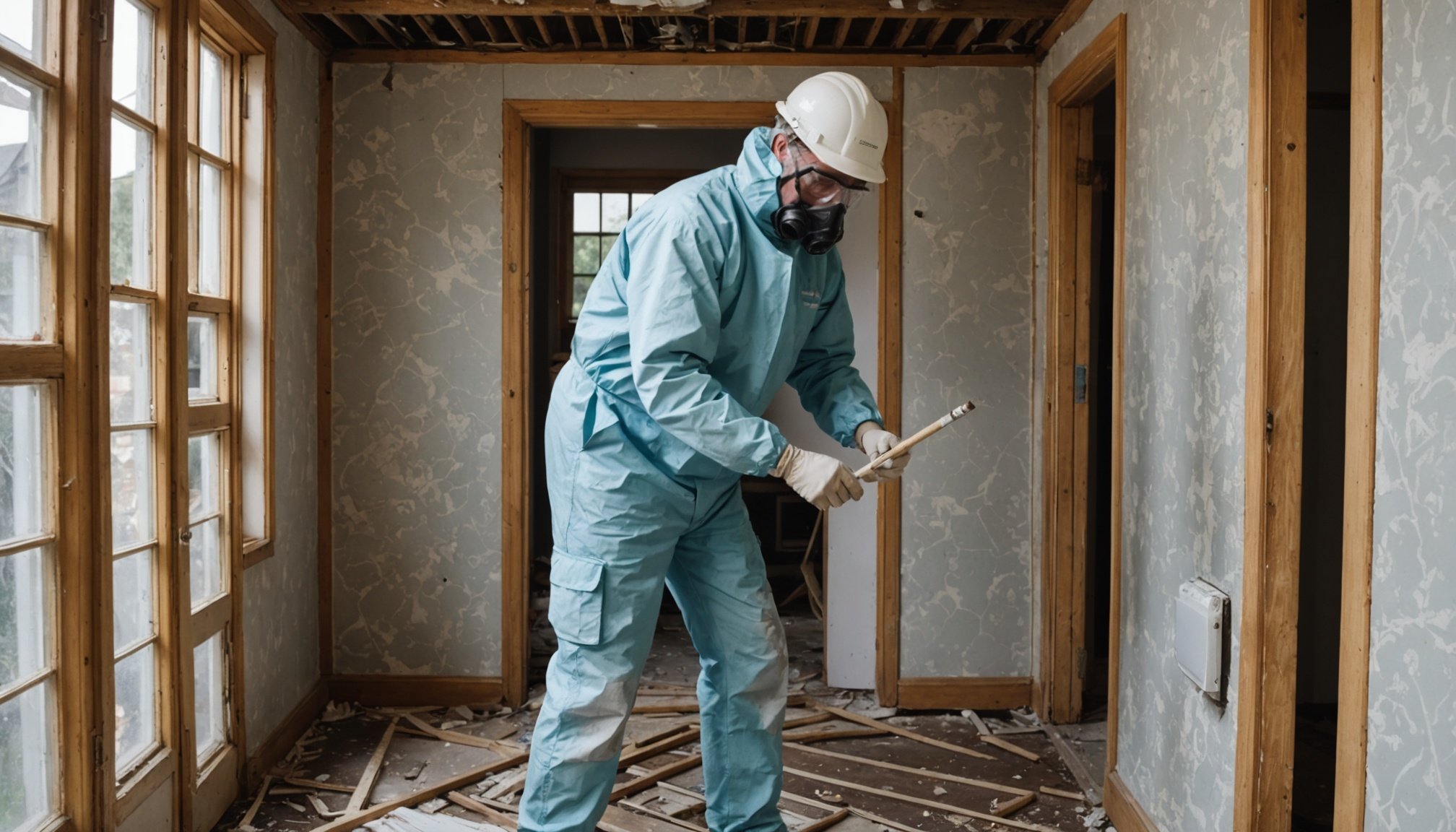Understanding Asbestos and Its Risks
Asbestos is a naturally occurring mineral composed of thin, needle-like fibres. It was commonly used in older homes for its resistance to heat and chemicals. You might find asbestos in materials like insulation, roofing, and tiles. In homes built before the 1980s, asbestos may still be lurking in walls and flooring.
The health risks associated with asbestos are significant. Exposure to these fibres can lead to serious lung conditions, such as asbestosis, lung cancer, and mesothelioma. These diseases may develop over time, often appearing decades after initial exposure.
En parallèle : Top Techniques for Minimizing Noise Pollution in Your Birmingham City Center Apartment
Identifying asbestos in a home can be tricky. It’s not easily detectable without proper testing, but some signs might include deteriorating sections of insulation or old ceiling tiles. Professional testing is essential for accurate identification and risk assessment.
If you suspect asbestos presence, don’t panic. Avoid disturbing the suspected material, as this can release dangerous fibres into the air. Consulting environmental health experts ensures safety in evaluating and mitigating any asbestos concerns in your home. Always prioritise health by being informed about the potential risks of asbestos exposure.
Lire également : Step-by-Step Guide to Installing a Gray Water System in Your New Exeter Home
Local Asbestos Regulations in Hull
Understanding the Hull regulations concerning asbestos is essential for anyone involved in renovation projects in this area. Local laws are in place to ensure the safe handling and removal of asbestos materials, which is crucial for protecting public health and the environment.
In Hull, specific legal requirements must be met before commencing any renovation that might disturb asbestos. This includes obtaining necessary permits from local authorities. Furthermore, notifications are required for any planned asbestos handling or removal. This ensures that all parties involved are aware of the potential hazards and can take appropriate safety measures.
Compliance with these regulations is not only a legal obligation but also a responsibility to the community. Failure to adhere to the compliance requirements can lead to significant consequences, including hefty fines and legal action. Ensuring compliance involves thorough planning, engaging qualified asbestos removal professionals, and maintaining accurate records of all activities related to asbestos handling.
Local authorities provide guidelines to assist with compliance, highlighting the importance of these measures. By understanding and following the legal requirements, individuals and businesses can ensure that their renovation projects proceed safely and legally, fostering a safer community for all.
Safety Protocols for Handling Asbestos
When dealing with asbestos safety, following the proper handling guidelines is crucial to minimise health risks. Homeowners undertaking renovations should first identify if their home contains asbestos materials. If confirmed, disturbing these materials without proper precautions can release hazardous fibres into the air. Adhering to detailed protocols is vital to ensuring safety.
Before starting, create a controlled work environment. Seal off the renovation area using plastic sheeting and tape to contain any potential fibre release. This measure safeguards both the workers and other areas of the home. Further containment can be achieved by wetting the asbestos material, reducing airborne dust.
In terms of protective gear, wearing suitable equipment is non-negotiable. A high-efficiency particulate air (HEPA) filter respirator protects your respiratory system, while disposable coveralls and gloves prevent skin contact. Eye protection is also crucial to avoid fibre irritation. These pieces of equipment form a robust barrier against asbestos exposure.
Following these handling guidelines, post-renovation cleaning involves carefully removing debris and contaminated gear, disposing of them according to local regulations. Never sweep or vacuum asbestos debris, as this can worsen fibre dispersion. By adhering to these safety protocols, you can effectively manage asbestos risks during renovations.
Best Practices for Asbestos Removal
Tackling asbestos removal requires a careful approach to ensure safety. When contemplating a DIY endeavour, it is crucial to follow a structured method to protect yourself and others. Begin by preparing the area: seal air vents and cover all surfaces with plastic sheeting to contain any fibres. Always wear protective gear, including masks, gloves, and coveralls, to minimise exposure. Wet the asbestos material slightly to reduce dust before attempting to remove it.
As a rule-of-thumb, DIY removal is only advisable for small, manageable quantities. For larger or more complicated incidents, consider when to seek professional help. Professionals are equipped with specialised tools and possess the knowledge to manage asbestos safely without risk to health.
Several factors should influence the decision to hire licensed asbestos abatement services. These include the extent of asbestos present and the complexity of removal involved. If the asbestos is in poor condition or if the materials are friable, enlisting experts becomes necessary for ensuring personal safety. Furthermore, professionals adhere to regulations and disposal requirements, providing peace of mind that the process is conducted lawfully and efficiently.
In sum, whether tackling the task yourself or opting for professional intervention, understanding the inherent risks and necessary precautions is vital.
Disposal of Asbestos Waste
Disposing of asbestos waste is crucial for ensuring both safety and environmental protection. During renovations, asbestos-containing materials can pose health risks if not handled properly. The first step is adhering to correct procedures for asbestos disposal. This involves wearing the appropriate protective gear, sealing asbestos waste in clearly labelled, sturdy bags, and ensuring that these bags remain intact until they reach disposal sites. Hull residents have access to specific locations for waste management, aimed at minimizing exposure to asbestos fibres.
Legal Disposal Sites in Hull
In Hull, several local disposal sites are authorised to receive asbestos waste. These sites are equipped to handle and process asbestos safely, preventing contamination of the surrounding environment. For example, the Hull Recycling Centre is dedicated to the safe disposal of such hazardous waste. Residents should contact their local council to verify the nearest authorised site and learn about any specific drop-off procedures.
Proper asbestos disposal is not just a matter of following guidelines but is a legal requirement to protect the environment and public health. Environmental contamination can result from improper handling and disposal, posing significant risks to ecosystems and human health. By following established procedures and utilising legal disposal sites, individuals can contribute to cleaner and safer communities.
Additional Resources and Support
Understanding asbestos management can be challenging. Fortunately, several asbestos resources and organisations are available to provide guidance. For those seeking additional support, a variety of local support services can assist homeowners dealing with asbestos.
Asbestos awareness organizations offer comprehensive guidance on safety measures and the identification of asbestos-containing materials. They provide resources such as helplines and consultative services that ensure accurate and timely information for homeowners.
For more personal assistance, many areas have local councils or support groups. These local support networks are instrumental in helping residents navigate the complexities of asbestos management, offering both practical advice and emotional support during the process.
Additionally, educational materials are crucial for gaining a deeper understanding of asbestos. Many websites and public health agencies offer free publications, informative videos, and online courses aimed at demystifying asbestos management. These resources help individuals make informed decisions and safely address any asbestos-related concerns.
These combined efforts — from organisations to local services and educational initiatives — empower individuals with the knowledge and confidence needed to manage asbestos effectively and safely. By utilizing these resources, homeowners can navigate asbestos issues with assurance and competence.











